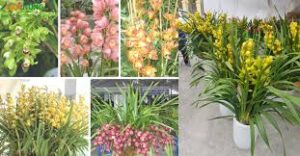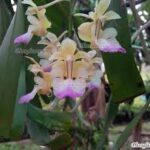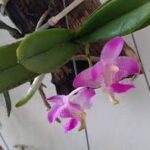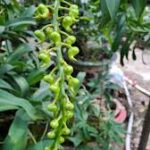
Sato Cymbidium orchids are celebrated for their stunning beauty, intricate patterns, and vibrant colors, making them a popular choice for both indoor and outdoor gardening enthusiasts. However, caring for these exquisite flowers in urban settings presents unique challenges, including limited space, varying light conditions, and air pollution. This guide will provide you with detailed insights and practical tips on how to successfully care for Sato Cymbidium orchids in urban environments.
## 1. Understanding Sato Cymbidium Orchids
### 1.1 Overview of Sato Cymbidium Orchids
Sato Cymbidium orchids, a popular hybrid species of the Cymbidium genus, are native to Southeast Asia and known for their large, showy blooms. These orchids typically flourish in well-drained potting media and require specific care to thrive.
– **Appearance**: Sato Cymbidium orchids feature elongated, strap-like leaves and large clusters of flowers that can come in various colors, including white, yellow, pink, and green. The blooms can last for several weeks, adding an elegant touch to any environment.
– **Habitat**: In their natural habitat, these orchids thrive in warm, humid environments, typically found in tropical and subtropical regions.
### 1.2 Importance of Urban Gardening
Urban gardening is becoming increasingly popular as more people live in cities and seek ways to connect with nature.
– **Benefits of Urban Gardening**: Growing plants in urban areas can improve air quality, reduce stress, and enhance mental well-being. Urban gardening also promotes biodiversity and provides an opportunity for individuals to grow their own food or ornamental plants.
– **Challenges**: Urban environments often present obstacles such as limited space, pollution, and varying sunlight conditions. Understanding these challenges is essential for successfully caring for Sato Cymbidium orchids in such settings.
## 2. Selecting the Right Location
### 2.1 Indoor vs. Outdoor Care
Before diving into specific care techniques, it’s essential to determine whether you will be growing your Sato Cymbidium orchids indoors or outdoors.
– **Indoor Growing**: Indoor environments can provide more controlled conditions, such as stable temperatures and humidity levels. However, indoor spaces may have limited natural light, requiring artificial grow lights.
– **Outdoor Growing**: Growing Sato Cymbidium orchids outdoors can take advantage of natural sunlight and fresh air. However, outdoor conditions can be unpredictable, with potential exposure to wind, rain, and pests.
### 2.2 Choosing the Ideal Spot
Regardless of whether you choose to grow indoors or outdoors, selecting the right location is crucial for the health of your orchids.
– **Light Requirements**: Sato Cymbidium orchids require bright, indirect light. Direct sunlight can scorch their leaves, while insufficient light can hinder blooming. Ideally, place them near east or west-facing windows where they can receive ample filtered light.
– **Temperature Considerations**: These orchids thrive in temperatures between 60°F and 75°F (15°C to 24°C). Ensure the location avoids extreme temperature fluctuations, as this can stress the plants.
– **Humidity Levels**: Urban environments often have low humidity, which can adversely affect orchid health. Aim for humidity levels of around 50-70%. If growing indoors, consider using a humidifier or placing a tray of water near the orchids to increase humidity.
### 2.3 Avoiding Pollution
In urban settings, air pollution can impact plant health. Consider the following:
– **Air Quality**: Choose locations away from heavy traffic and industrial areas where air quality may be compromised. Poor air quality can lead to stress and disease in your orchids.
– **Ventilation**: Ensure good airflow around your orchids to help reduce the risk of fungal diseases. Avoid overcrowding plants, which can hinder air circulation.
## 3. Potting and Soil Requirements
### 3.1 Choosing the Right Pot
Selecting the appropriate pot for your Sato Cymbidium orchids is crucial for their growth and development.
– **Material**: Clay or plastic pots are common choices. Clay pots are porous and allow for better air circulation, while plastic pots retain moisture longer. Choose based on your watering habits and the climate conditions.
– **Size**: Opt for pots that are 1-2 inches larger in diameter than the root ball of your orchid. Avoid oversized pots, as this can lead to water retention and root rot.
### 3.2 Ideal Soil Mix
The soil mix used for Sato Cymbidium orchids should provide excellent drainage and aeration.
– **Commercial Orchid Mix**: Look for a commercial orchid mix designed specifically for orchids. These mixes typically contain ingredients such as bark, perlite, and charcoal to promote drainage.
– **Homemade Mix**: You can also create your own mix by combining equal parts of bark, perlite, and sphagnum moss. This blend provides both aeration and moisture retention, ensuring your orchids receive the right conditions for growth.
## 4. Watering Techniques
### 4.1 Understanding Watering Needs
Proper watering is one of the most critical aspects of orchid care, especially in urban environments where conditions can vary.
– **Frequency**: Sato Cymbidium orchids prefer to dry out slightly between waterings. Generally, watering every 1-2 weeks is sufficient, but this can vary based on environmental conditions. Factors such as temperature, humidity, and pot size will affect how quickly the soil dries out.
– **Signs of Overwatering**: Overwatering can lead to root rot, so it’s crucial to recognize signs such as yellowing leaves and mushy roots. Ensure the pot has drainage holes to allow excess water to escape.
### 4.2 Water Quality
The quality of water used can significantly impact the health of your orchids.
– **Water Type**: Ideally, use distilled or rainwater, as tap water may contain chemicals and minerals that can harm orchids over time. If using tap water, let it sit out for 24 hours to allow chlorine to dissipate.
– **Temperature**: Water your orchids with lukewarm water, as cold water can shock the roots.
## 5. Fertilization Strategies
### 5.1 Choosing the Right Fertilizer
Fertilizing Sato Cymbidium orchids is essential for their growth and blooming.
– **Balanced Fertilizer**: Use a balanced orchid fertilizer with an NPK ratio of 30-10-10 or similar during the growing season (spring and summer). This ensures they receive the necessary nutrients for robust growth.
– **Slow-Release Fertilizers**: Alternatively, you can use slow-release fertilizers specifically formulated for orchids. These will provide consistent nutrition over an extended period.
### 5.2 Fertilization Schedule
Establishing a regular fertilization schedule is vital for optimal growth.
– **Frequency**: Fertilize your orchids every 4-6 weeks during the growing season and reduce feeding during the dormant period in fall and winter.
– **Dilution**: Always dilute fertilizers to half strength before applying to avoid burning the roots.
## 6. Managing Pests and Diseases
### 6.1 Common Pests
Urban environments can expose Sato Cymbidium orchids to pests, which can be detrimental to their health.
– **Common Pests**: Common pests include aphids, spider mites, mealybugs, and scale. Regularly inspect your orchids for signs of infestation, such as webbing or sticky residue.
– **Prevention**: Maintain good air circulation and humidity levels, as this can help deter pests. Regularly cleaning leaves can also prevent pest buildup.
### 6.2 Disease Management
Understanding common diseases that affect orchids can help you take proactive measures.
– **Fungal Infections**: Overwatering and poor air circulation can lead to fungal infections. Ensure proper watering practices and airflow to minimize risks.
– **Bacterial Infections**: These can manifest as soft rot or leaf spots. If you notice these symptoms, remove affected areas and improve drainage to prevent further spread.
## 7. Conclusion
Caring for Sato Cymbidium orchids in urban conditions can be rewarding with the right knowledge and practices. In this first part of our comprehensive guide, we’ve explored the essentials of understanding these orchids, selecting the right location, potting and soil requirements, watering techniques, fertilization strategies, and pest and disease management.
In the second part of this guide, we will delve into more advanced care techniques, including how to encourage blooming, propagate Sato Cymbidium orchids, and create a thriving urban garden that incorporates these stunning flowers. By following the tips outlined in this guide, you can enjoy the beauty of Sato Cymbidium orchids and contribute to the greening of your urban environment.
# Caring for Sato Cymbidium Orchids in Urban Conditions: A Comprehensive Guide (Part 2)
In the first part of our comprehensive guide on caring for Sato Cymbidium orchids in urban environments, we explored the basics of understanding these orchids, selecting suitable locations, potting and soil requirements, watering techniques, fertilization strategies, and pest and disease management. This second part will delve into more advanced care techniques to ensure that your Sato Cymbidium orchids thrive in urban conditions. We will cover how to encourage blooming, propagate your orchids, create a thriving urban garden, and address common concerns specific to urban gardening.
## 8. Encouraging Blooming
### 8.1 Understanding the Blooming Cycle
Sato Cymbidium orchids typically bloom during the late winter to early spring, making it essential to provide the right conditions leading up to this period.
– **Light and Temperature**: To encourage blooming, provide bright but indirect light, as mentioned earlier. Additionally, lowering temperatures during the night (around 55°F to 60°F or 13°C to 15°C) for a few weeks can simulate natural conditions and trigger blooming.
– **Watering Adjustments**: Reduce watering slightly as the blooming period approaches. Allow the plant to dry out a bit more between waterings to promote flower development.
### 8.2 Stimulating Flower Production
To encourage more prolific blooming, consider the following strategies:
– **Use of Blooming Fertilizers**: Switch to a high-phosphorus fertilizer (with an NPK ratio like 10-30-20) in the weeks leading up to the expected bloom period. Phosphorus supports flower development and enhances color.
– **Proper Pruning**: After flowering, prune spent flower spikes back to their base. This encourages new growth and prepares the plant for future blooms. Always use sterilized tools to prevent the spread of diseases.
### 8.3 Creating Ideal Conditions for Blooming
To achieve optimal blooming results, ensure the following:
– **Humidity**: Maintain humidity levels of 50-70% during the blooming period. This can be achieved using a humidifier or placing trays of water with pebbles under the pots.
– **Good Air Circulation**: Adequate airflow prevents fungal issues and ensures the flowers develop correctly. Position fans in the vicinity of your orchids if necessary.
## 9. Propagating Sato Cymbidium Orchids
### 9.1 Understanding Propagation Methods
There are various methods to propagate Sato Cymbidium orchids, but the most common is division.
– **Division**: This involves separating a mature plant into smaller sections, each with roots and growth points. Ideal times for division are in the spring or early summer, following blooming.
### 9.2 Steps for Successful Division
Follow these steps to successfully divide your orchids:
1. **Prepare Your Tools**: Sterilize a sharp knife or garden shears with rubbing alcohol to prevent contamination.
2. **Remove the Orchid from the Pot**: Carefully remove the orchid from its pot, taking care not to damage the roots.
3. **Identify Division Points**: Look for natural separations in the root mass. Each division should ideally have 2-3 pseudobulbs.
4. **Cut and Re-pot**: Cut the divisions apart and remove any dead or damaged roots. Pot each division in a suitable orchid mix, ensuring good drainage.
5. **Watering and Care**: Water the newly potted divisions lightly and keep them in a humid, shaded area until they establish roots.
### 9.3 Additional Propagation Methods
While division is the most common method, Sato Cymbidium orchids can also be propagated via:
– **Keiki (Offshoots)**: Keiki can grow on flower spikes. Allow them to develop roots before gently removing and potting them.
– **Tissue Culture**: Advanced growers may use tissue culture techniques, which allow for large-scale propagation under sterile conditions.
## 10. Creating a Thriving Urban Garden
### 10.1 Designing Your Urban Space
Creating a thriving urban garden involves thoughtful planning and design, particularly if you wish to incorporate Sato Cymbidium orchids.
– **Container Gardening**: Utilize containers to make the most of limited space. Choose pots that complement your orchids and allow for good drainage.
– **Vertical Gardening**: Implement vertical gardening techniques, such as wall-mounted planters, to maximize growing space and enhance aesthetic appeal.
### 10.2 Plant Companions
Choosing the right companion plants can enhance the overall health and beauty of your urban garden.
– **Compatible Plants**: Select plants that thrive in similar conditions to Sato Cymbidium orchids. For example, ferns, bromeliads, or other orchids can complement their growing requirements.
– **Diversity and Benefits**: A diverse garden promotes biodiversity, helps deter pests, and enhances pollination.
### 10.3 Managing Space Limitations
Urban spaces often have restrictions on size and layout, so consider these strategies:
– **Utilizing Balconies and Patios**: If you have a balcony or patio, these can be excellent locations for your orchids and other plants. Ensure they receive sufficient light and protection from strong winds.
– **Rooftop Gardens**: If you have access to a rooftop, consider creating a garden there. Rooftop gardens can help reduce heat and improve air quality in urban areas.
## 11. Addressing Urban Gardening Concerns
### 11.1 Pollution and Its Impact
Urban pollution can adversely affect plant health, including Sato Cymbidium orchids. Here’s how to manage it:
– **Filtration Systems**: If growing indoors, consider using air purifiers to remove pollutants and improve air quality for your orchids.
– **Water Quality**: As mentioned earlier, using distilled or rainwater can mitigate issues caused by chemicals in tap water.
### 11.2 Dealing with Limited Sunlight
Limited sunlight can pose a challenge for urban gardeners, particularly if you are growing indoors.
– **Grow Lights**: Invest in quality grow lights to supplement natural light. LED grow lights are energy-efficient and effective for promoting plant growth.
– **Window Treatments**: Use sheer curtains to filter light without blocking it completely, ensuring your orchids receive adequate indirect sunlight.
### 11.3 Managing Space and Accessibility
Accessibility is crucial when caring for your orchids, especially in urban environments.
– **Vertical Space Utilization**: Consider using shelves or hanging planters to make the most of vertical space and allow easy access for maintenance.
– **Mobile Plant Stands**: Use mobile plant stands to move your orchids closer to light sources or out of the way when needed.
## 12. Seasonal Care Tips
### 12.1 Spring and Summer Care
During the growing season, your Sato Cymbidium orchids will thrive with the right care:
– **Increase Watering Frequency**: As temperatures rise, increase watering frequency but ensure proper drainage to avoid root rot.
– **Fertilization**: Continue using a balanced fertilizer to support growth and blooming.
### 12.2 Fall and Winter Care
As the growing season comes to a close, adjust your care practices accordingly:
– **Reduce Watering**: Cut back on watering as temperatures drop, allowing the plants to enter a semi-dormant state.
– **Temperature Monitoring**: Protect orchids from cold drafts and extreme temperature changes during the winter months.
## 13. Troubleshooting Common Issues
### 13.1 Leaf Issues
– **Yellowing Leaves**: This may indicate overwatering or nutrient deficiencies. Check the watering schedule and consider adjusting fertilization.
– **Wilting Leaves**: Wilting can be a sign of underwatering. Ensure the potting medium is moist but not soggy.
### 13.2 Flowering Problems
– **Failure to Bloom**: If your orchids fail to bloom, it may be due to inadequate light or temperature fluctuations. Ensure they are receiving the right conditions and consider providing a resting period.
## 14. Conclusion
Caring for Sato Cymbidium orchids in urban environments requires attention to detail, adaptability, and a willingness to learn. By understanding the specific needs of these beautiful flowers and implementing the strategies outlined in this guide, you can create a thriving urban garden that showcases the beauty of Sato Cymbidium orchids.
From encouraging blooming to propagating your orchids and managing urban gardening challenges, your dedication will be rewarded with vibrant blooms and a deeper connection to nature. Embrace the joy of nurturing these stunning plants, and enjoy the many benefits that urban gardening has to offer. With the right care, your Sato Cymbidium orchids will thrive, bringing beauty and tranquility to your urban space for years to come.










